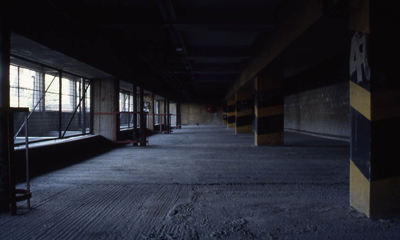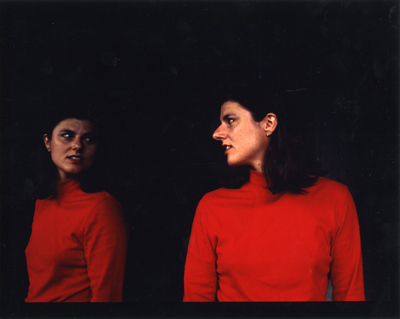Jacqueline Pennell
- Jacqueline Pennell – Press release
- Foreword, Mirror Mirror: Jacqueline Pennell – Rear Window
- The Other Site, Towards a Definition of Site-specificity – Jean-Paul Martinon
- From a Rear Window — Extract from a Journal – Peter Cross
- Mirror Mirror: Jacqueline Pennell – Rear Window
19 July – 15 September 1996
Rear Window, Sara Lane Studios, Stanway Street, London N1
“The poet stands in front of the mirror. The poet is startled. He touches the mirror. His ring strikes it three times, but the sound is heard later than the contact. The poet hesitates, looks to his left, puts one foot on the edge of the frame, then the other. He grabs hold of the frame with both hands. He looks harder at the mirror than he does at his own reflection.
“The statue’s voice: ‘Try…’ The poet throws himself into the glass. His disappearance is accompanied by the sound of a crowd at a firecracker party.
“(The mirror has been substituted by a tank of water, the setting is upside down, the chair nailed on the left. This is all shot from above. The actor plunges. A quick cut back to the room as it was, ends the illusion.)”
Extract taken from the script of The Blood of a Poet by Jean Cocteau, translated by Carol Martin-Sperry (London: Marion Boyars, 1995), pp. 20-1.
Every two years, as part of The Open, 1,000 Eat London artists open their studios to the general public. This event, organised by the Whitechapel Art Gallery constitutes the largest contemporary art exhibition of the year. However, unlike any art exhibition localised in a “neutral” space, this one is spread over 1,000 studios scattered over 29 postal districts.
Considering this context, Rear Window has invited artist Jacqueline Pennell, who has opened her studio to the public in the past, to explore the concept of the artist’s studio and the purpose of this biennial opening ritual.
The installation involves sectioning off part of a disused space in a studio block (recently leased by Space Studios) and transforming it into a “corridor” where architectural features on ceiling and walls are mirrored on the floor and at one end, reflecting the space back into itself. In addition to this, sound will add another dimension of echoing fiction.
This work draws attention to the position of the viewer within the open studio, where work is traditionally shown either on plinths or on white-washed walls. The aim, which mirrors the 1,000 other participating studios is the opening to the public of a private space in which a piece of work has been conceived. However, in this case, the viewer may enter a domain where it is uncertain as to who or what takes the primary role on centre stage.
A catalogue exploring the notion of site-specificity will be published for the occasion.





